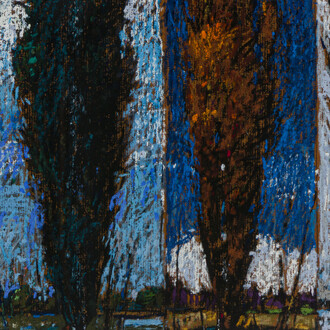Bay Area surrealist landscape pioneer presents a synthesis of Eastern and Western cosmogeny in forthcoming multidisciplinary exhibition.
Invisible features mixed media paintings, watercolor on paper, and ceramics adorned with found objects by New Mexico-based artist Bunny Tobias. This forthcoming exhibition showcases the latest iterations of Tobias’s surreal landscapes that combine biological figuration, scientific realism, and ecological abstraction. With their luminous centers and compositions influenced by the untamed beauty of nature, Tobias’s latest paintings present landscape aesthetics informed by her study of Eastern literati such as Matsuo Bashō, Kobayashi Issa, and Laozi Tzu; Western literary figures, such as Jack Kerouac, Fernando Pessoa, Walt Whitman, and Virginia Woolf; as well as her experience as a pioneer of San Francisco’s psychedelic surrealist movement (1960s–70s). Invisible opens on October 31 from 5 to 7 PM on the ground floor of the gallery.
“The philosophical perspective in Tobias’s paintings renders the world as a unified entity of ordered chaos through repetition, symmetry, visual rhyme and rhythm, and the integration of common elements from haiku, such as koi fish, frogs, and butterflies,” writes Spencer Linford. “Similar to the method of composition found in ca. 17th- to 18th-century Japanese woodblock prints, Tobias’s paintings use scale and space to shift viewer attention away from individual figures and toward formal and metaphorical relationships between beings and their environments.”
The exhibition title, Invisible, comes in part from Tobias’s recent foray into writing haiku and free verse—poetry forms that have comforted the artist in the wake of personal loss. Exemplary practitioners of these forms, such as Matsuo Bashō and Walt Whitman, have served as thematic and process-based inspirations for Tobias and her most recent body of work. Both Bashō and Whitman emphasized the immense and ultimately unknowable beauty of nature and elevated their respective genres of poetry in the literary canon through sustained and playful experimentation. In her latest ceramic works, which feature ephemera partially sourced from around her 200-year-old property outside Santa Fe, NM, Tobias embraces Bashō and Whitman’s playful spirit by repurposing found objects into works that aim to elicit “unexpected logic and rhythms, perverse and unpredictable associations, and comic improvisations.” Among Laozi-Tzu’s writings that resonated with Tobias are the following lines:
That which cannot be seen is called invisible.
That which cannot be heard is called inaudible.
That which cannot be held is called intangible.
These three cannot be defined;
therefore, they are merged as one. [...]Then the unseen,
unheard,
and untouched are present as one. [...]Approach it and there is no beginning;
follow it and there is no end.
You cannot know it,
but you can be it,
at ease in your own life.
form & concept gallery director, Carina Evangelista, notes, “Tobias renders visible phantasmagoric worlds of meticulously drawn and painted organic forms–tendrils, irises, roots, coral branches, butterfly wings, kelp bulbs, and bacterial swarms that gracefully swim and swirl, animating the canvases. Fairies hang like pupae from branches. Unidentifiable creatures are formed with collaged elements. Faces, anatomical parts, insects, fish, leaves, and rock formation sourced from books are almost seamlessly incorporated within the pictorial compositions. Mica shells add texture and sheen, completing Tobias’s more whimsical versions of Hieronymus Bosch’s The garden of Earthly delights, as if to offer neither warning nor parable but instead the visual anodyne to what ails contemporary times or to lift the veil and reveal Pessoa’s ‘My soul is a hidden orchestra.’”













